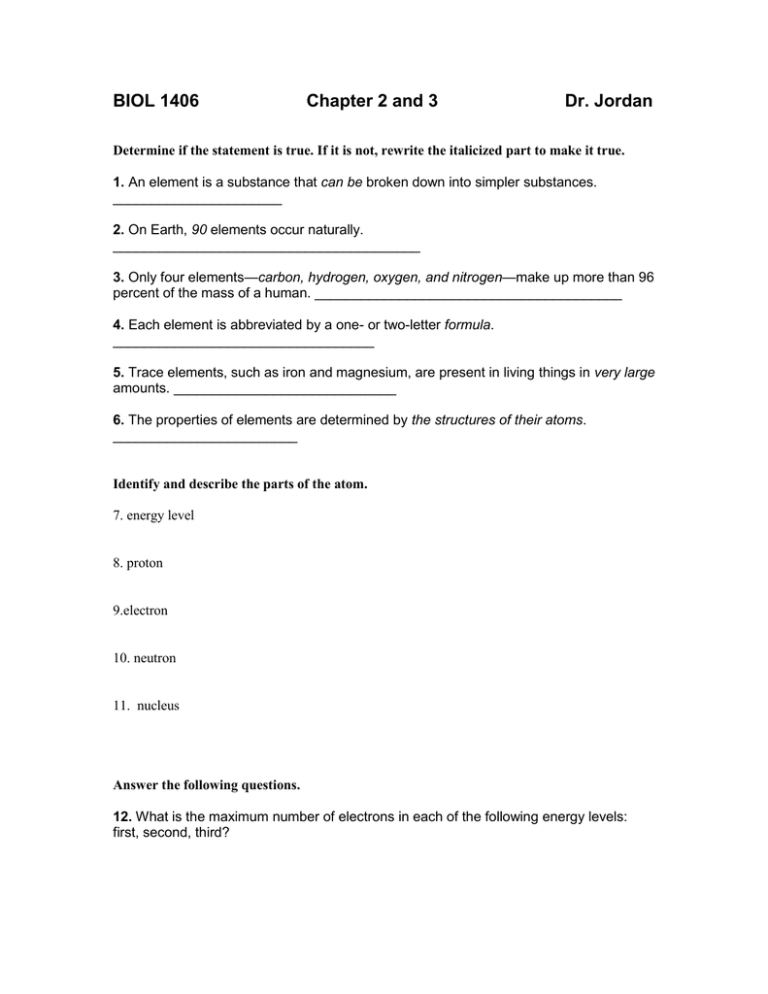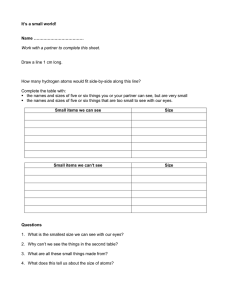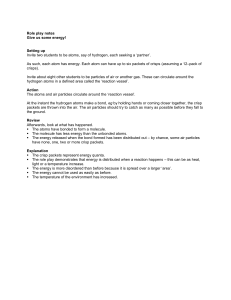Worksheet CH 2 AND 3.doc
advertisement

BIOL 1406 Chapter 2 and 3 Dr. Jordan Determine if the statement is true. If it is not, rewrite the italicized part to make it true. 1. An element is a substance that can be broken down into simpler substances. ______________________ 2. On Earth, 90 elements occur naturally. ________________________________________ 3. Only four elements—carbon, hydrogen, oxygen, and nitrogen—make up more than 96 percent of the mass of a human. ________________________________________ 4. Each element is abbreviated by a one- or two-letter formula. __________________________________ 5. Trace elements, such as iron and magnesium, are present in living things in very large amounts. _____________________________ 6. The properties of elements are determined by the structures of their atoms. ________________________ Identify and describe the parts of the atom. 7. energy level 8. proton 9.electron 10. neutron 11. nucleus Answer the following questions. 12. What is the maximum number of electrons in each of the following energy levels: first, second, third? 13. Boron has two isotopes, boron-10 and boron-11. Boron-10 has five protons and five neutrons. How many protons and neutrons does boron-11 have? Explain. . Write the type of substance described. Use these choices: compound, element. ____________________ 14. H2O, a liquid that no longer resembles either hydrogen or oxygen gas ____________________ 15. A substance that can be broken down in a chemical reaction ____________________ 16. Carbon, the substance represented by the symbol C Complete the table by checking the correct column for each description. Statement Ionic Bond(s) Covalent Bond(s) 17. Found in the compound NaCl 18. Increases the stability of atoms 19. Results in the formation of a molecule 20. Is formed when atoms share electrons Fill in the blanks with the correct number of molecules to balance the chemical equation. Then answer the questions. C6H12O6 + _____O2 _____CO2 + ______H2O 21. Why must chemical equations always balance? 22. Which number indicates the number of atoms of each element in a molecule of a substance. 23. When is a mixture not a solution? 24. What is the difference between an acid and a base? For each statement below, write true or false. ____________________ 1. In a water molecule, electrons are shared equally between the hydrogen atoms and oxygen atom. ____________________ 2. The attraction of opposite charges between hydrogen and oxygen forms a weak oxygen bond. ____________________ 3. Because of its polarity, water can move from the roots of a plant up to its leaves. ____________________ 4. Water changes temperature easily. ____________________ 5. Unlike most substances, water expands when it freezes. Circle the letter of the choice that best completes the statement. 6. All objects in motion have a. potential energy. b. heat energy. c. kinetic energy. d. random energy. 7. The first scientist to observe evidence of the random motion of molecules was a. Brown. b. Darwin. c. Mendel. d. Hooke. 8. The net movement of particles from an area of higher concentration to an area of lower concentration is called a. dynamic equilibrium. b. nonrandom movement. c. concentration gradient. d. diffusion. 9. Diffusion occurs because of a. nonrandom movement of particles. b. random movement of particles. c. a chemical reaction between particles. d. chemical energy. 10. When a few drops of colored corn syrup are added to a beaker of pure corn syrup, the color will a. move from low concentration to high concentration. b. form a polar bond. c. start to diffuse. d. remain on the bottom of the beaker. 11. Diffusion can be accelerated by a. decreasing the pressure. b. increasing the temperature. c. decreasing the movement of particles. d. increasing the dynamic equilibrium. 12. When materials pass into and out of a cell at equal rates, there is no net change in concentration inside the cell. The cell is in a state of a. dynamic equilibrium. b. metabolism. c. imbalance. d. inertia. 13. The difference in concentration of a substance across space is called a. dynamic equilibrium. b. concentration gradient. c. diffusion. d. Brownian movement.





